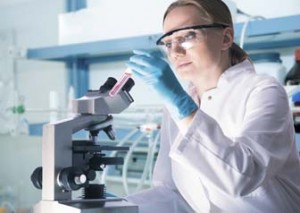

Carry out an autopsy: Open the deceased person`s body and remove the organs for examination, interpreting the findings in the context of the clinical history.Assist with reconstructing the body after autopsy: Assist with the reconstruction and cleaning of the deceased body after post-mortem examinations.Observe confidentiality: Observe the set of rules establishing the nondisclosure of information except to another authorised person.Provide information on mortuary services: Provide information support related to documentation such as death certificates, cremation forms and any other type of documents required by authorities or families of the deceased.
PATHOLOGY TECHNICIAN PROFESSIONAL
Follow clinical guidelines: Follow agreed protocols and guidelines in support of healthcare practice which are provided by healthcare institutions, professional associations, or authorities and also scientific organisations.Communicate effectively in healthcare: Communicate effectively with patients, families and other caregivers, health care professionals, and community partners.Perform mortuary facility administration: Implement the day-to-day running of the mortuary service by ensuring the instruments are clean and sterile, placing the bodies into cold storage departments, tracking the samples of the deceased and keeping accurate records related to the activities in the mortuary room.Take samples during autopsy: Collect samples from the deceased body such as bodily fluids and tissues for clinical examination, transplant purposes or research.Cope with unusual stimuli in the mortuary facility: Deal with strong smells and traumatic sights of deaths from road traffic collisions, suicides or suspicious death cases and keep calm and mental clarity.Select hazard control: Perform appropriate selection of hazard control measures and risk management.Deal sympathetically with the relatives who may visit the mortuary for identification or viewing of the deceased persons. Conduct visits to the postmortem room: Guide all visitors to the post-mortem room, making sure they wear the appropriate protective clothing and follow correct procedures.Follow control of substances hazardous to health procedures: Adhere to the Control of Substances Hazardous to Health (COSHH) procedures for activities that involve hazardous substances, such as bacteria, allergens, waste oil, paint or brake fluids that result in illness or injury.These skills are necessary for the role of anatomical pathology technician. Pathology: The components of a disease, the cause, mechanisms of development, morphologic changes, and the clinical consequences of those changes.Pathological anatomy: Pathological anatomy is a medical specialty mentioned in the EU Directive 2005/36/EC.Medical informatics: The processes and tools used for the analysis and dissemination of medical data through computerized systems.The requirements for death certifications and related documentation and for organ removal.


Hygiene in a health care setting: The procedures related to maintaining a hygienic environment within a health care setting such as hospitals and clinics.This knowledge should be acquired through learning to fulfill the role of anatomical pathology technician.


 0 kommentar(er)
0 kommentar(er)
